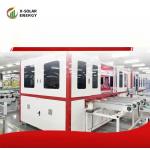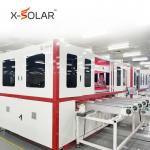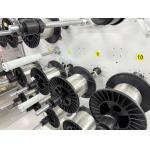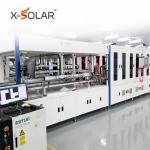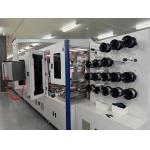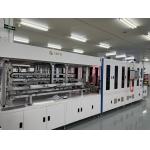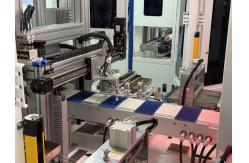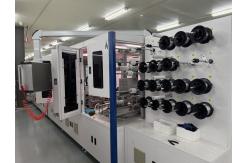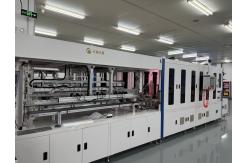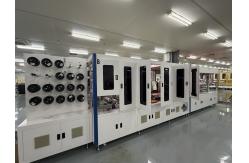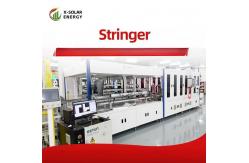Multi-Busbar PV String Welding Machine
Product Description
It is an automated production equipment
capable of string welding PV crystalline silicon solar cells,
characterized by high production capacity, high precision, and high
compatibility.
Product Parameters
| Product parameter | Data |
| Capacity | 6800 half pcs/hour |
| Welding Manner | Infrared Welding |
| Cell Size | 166-210 mm |
| No. of Main Busbars | Main Busbar Compatibility:10-20BB |
| Solder Wire Specifications | Round, Irregular Shape, Flat Ribbon |
| Air Consumption | ≥3200L/min |
| Power | Average Power: 37W Peak Power 45 kW |
| Weight | 13,500kg |
| Dimensions of the Equipment | 10,800*2,400*2,650 (L*W*H) |
Detailed Photos
string
arrangement
welding This Multi-Busbar PV String Welding Machine is highly
automited, without any manual operation. The speed is fast, it can
welding battery cell 6800 pieces per hour.
There is also a liquid crystal display to monitor every step
whether there are mistakes. The workers only need to standby and
check, and pick out the unqualified one.
There are so many windows in each side for inspector to watch the
whole production.
Company Profile
Beijing X-Solar Energy Co., Ltd.
was found in 2020, and headquartered in Beijing. It's a science and
technology innovative energy enterprises with the main business of
future cell R&D, flexible photovoltaic modules, building
photovoltaic module production, high-end equipment manufacturing,
production line delivery, and AI-CITY wisdom energy management
services.
In July
2023, the company's first demonstration factory, Jiangsu X-Solar
Green-building Technology Co., Ltd., was established in
Jiangyin CNBM Jetion Industrial Park. Meanwhile, Jiangsu
YuanTeng FengSheng Intelligent Manufacturing Technology Co., Ltd.,
a wholly-owned equipment company of the company, delivered the
world's first "three-in-one" automatic production line for Jiangyin
base. The production line can be compatible with the production of
three categories: X-Solar Light shadow series (flexible
PV modules), X-Solar Light rhyme series (building PVtile
modules), X-Solar Light Curtain series (building
PV wall modules), and customized products.
X-Solar PV series products have the advantages of
integrating architectural aesthetics, complying with design
specifications and creating energy value, which have been
widely recognized and praised by customers in domestic and
overseas.
In 2024, the
company has added two regional centers in Shanghai and
Guangzhou of China, and set up the Hong Kong
X-Solar Future Energy Research Institute, and overseas sales
companies in Australia, Italy, Germany, Saudi Arabia and Argentina.
The company has launched a global layout to provide sustainable
energy products and services to many countries, and has contributed
to the "carbon neutrality and carbon peak".
Exhibition Display
FAQ
Related to the basic principle of the equipment
1. Question: What is the working principle of the multi-busbar
photovoltaic string welder?
Answer: It mainly realizes the series connection of battery cells
by precisely positioning the photovoltaic battery cells with
multiple busbars through high-precision mechanical transmission
cooperating with the welding system, and then using appropriate
welding processes (such as infrared welding, laser welding, etc.)
to weld the busbars onto the main grid lines of the battery cells.
2. Question: What are the advantages of adopting the multi-busbar
technology compared with the traditional one?
Answer: The multi-busbar can reduce the current transmission
distance on the surface of the battery cell, decrease the
resistance loss, improve the photoelectric conversion efficiency of
the battery cell, and then increase the power output of the module.
Related to the welding process
1. Question: What are the commonly used welding methods and what
are their characteristics?
Answer: Commonly used ones include infrared welding, which features
uniform heating and relatively fast welding speed; laser welding
has high precision and good welding strength, but the equipment
cost is relatively high. Different processes are suitable for
different production requirement scenarios.
2. Question: How to ensure the stability of welding quality?
Answer: It is necessary to precisely control parameters such as
welding temperature, pressure, and welding time, regularly
calibrate the welding equipment, and at the same time ensure that
the surfaces of the battery cells and busbars are clean and flat,
and the materials are of qualified quality.
Related to the equipment operation
1. Question: What preparatory work needs to be done before starting
the equipment?
Answer: It is necessary to check whether the connections of all
parts of the equipment are normal, whether there are faults in the
electrical system, whether the transmission parts can operate
smoothly, clean the welding work area, and confirm that the welding
materials (busbars, etc.) are fully prepared.
2. Question: What should be done if a fault alarm occurs during the
operation process?
Answer: First, check the alarm prompt information, and judge
whether the problem is caused by electrical faults, mechanical
faults or abnormal welding parameters, etc. according to the
equipment operation manual. If it can be solved by yourself, handle
it according to the steps in the manual. If it cannot be solved,
contact professional maintenance personnel in time.
Related to production efficiency
1. Question: How to improve the production efficiency of the
multi-busbar photovoltaic string welder?
Answer: Optimize the welding parameters to reduce the welding time,
do a good job in the daily maintenance of the equipment to ensure
few shutdowns due to failures, arrange production batches
reasonably, and improve the proficiency of operators, all of which
will help improve the efficiency.
2. Question: What is the maximum production capacity that the
equipment can reach?
Answer: Different models and configurations of multi-busbar
photovoltaic string welders have different production capacities.
Generally, thousands of battery cells can be welded per hour. The
specific situation depends on the design specification parameters
of the equipment.
Related to maintenance
1. Question: What maintenance work needs to be done for the
equipment on a daily basis?
Answer: It is necessary to regularly clean the dust and debris on
the surface and inside of the equipment, add lubricating oil to the
transmission parts, check the wear condition of the welding heads,
calibrate the welding parameters, and check whether the connections
of electrical lines are loose.
2. Question: How often is it more appropriate to conduct a
comprehensive maintenance and overhaul?
Answer: It is recommended to conduct a comprehensive maintenance
and overhaul every 1 to 3 months according to the usage frequency
of the equipment to ensure that all aspects of the equipment's
performance are good and it can operate stably.
Related to product quality
1. Question: How to test the quality of the products after welding?
Answer: You can conduct appearance inspections to see whether the
welding joints are firm and whether there are problems such as poor
welding or detachment. Professional electrical testing equipment
can also be used to detect whether the electrical performance
indicators such as the series resistance after welding meet the
standards.
2. Question: How to handle the defective products after welding?
Answer: Analyze the causes of the defects. If it is a problem of
process parameters, adjust the parameters in time. If it is a
problem of materials, replace the qualified materials. Mark the
defective products, store them separately, and handle them
according to the relevant procedures for rework or scrapping.
